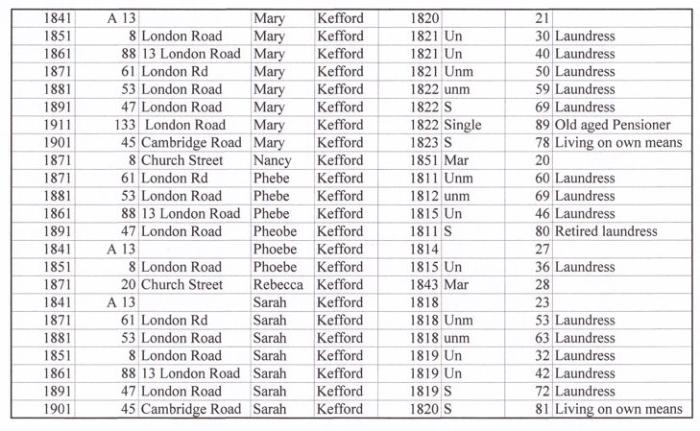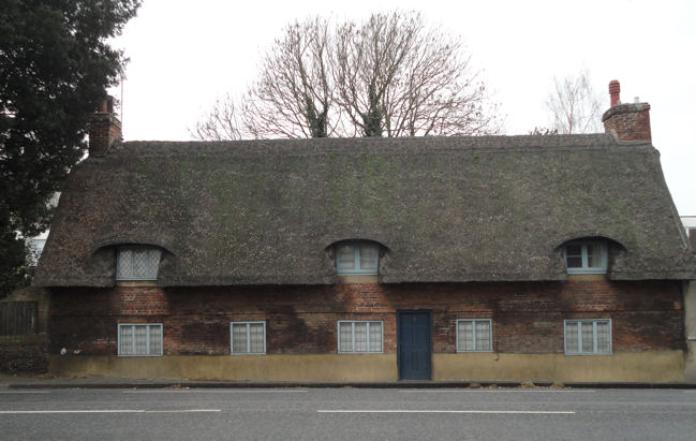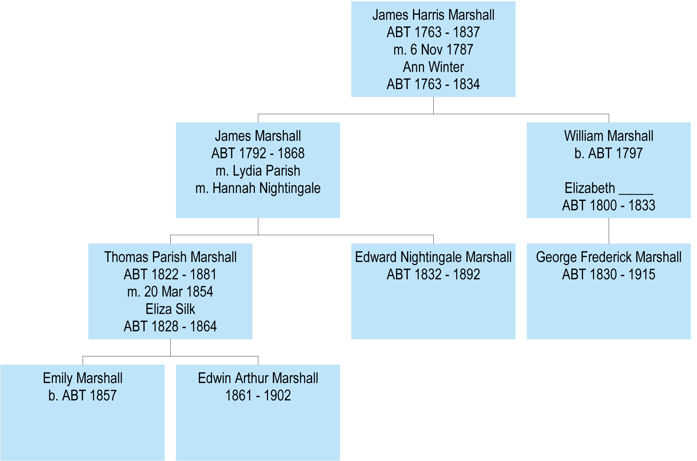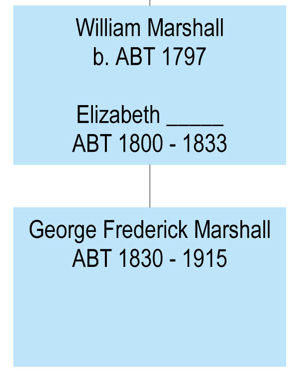December 2011
The Local History Group meeting on 24 November 2011 included presentations about Trumpington stories revealed by the censuses. This page is based on one of the presentations.
There is also an introduction to the series and an overview of the Trumpington censuses for 1841-1911.
Extract from Marshall family tree.
I have developed an ambition to construct a kind of family history of Trumpington, whereby users can look up people who lived in the village and find out what we know about them and how they were related to other people who have lived in Trumpington.
The censuses are an obvious place to start this process: over 4000 different people were listed between 1841 and 1911 and these records link back to the past and into the future. Of course, the censuses are far from being the only place to get hold of information about the ordinary people of Trumpington. I stress ‘ordinary’ here: it is comparatively easy to find out about the wealthy landowners, the vicars, the academics and others who lived in the big houses in Trumpington, but I am interested in the working class men and women who made up the vast majority of our population and who are mainly unsung.
The other major source of such information is, of course, the church parish registers. Here I must pay tribute to Margaret Marrs and her fellow transcribers who, after a marathon effort, produced a CD-ROM with all the entries from the registers from 1563 to 1950. This means I can look up information such as all the baptisms of children of a particular couple. Without this as an aid, it would be very difficult to bring together the church records with the other information we have from the censuses and elsewhere.
As well as these two major sources, there are plenty of other places to look, particularly for the years following 1911, when later censuses are not yet open to public view:
• street directories from 1935 onwards when Trumpington became part of Cambridge;
• electoral registers (I have digital photographs of many of these from 1915 to 1970);
• the national indexes of births, marriages and deaths, also searchable on the internet;
• records of various village organisations: for instance, we have access to the early record books of the Allotment Society and the Friendship Club;
• old copies of the Parish Magazine : I know that Shirley Brown has drawn on these for information to help with her books;
• and, last but by no means least, personal memories of our older residents.
I have now started the process of compiling a ‘Trumpington family history’, and so far have mustered about 1700 names of people who at some stage of their lives were in Trumpington, albeit in some cases only when they came here to get married or baptised! One thousand of these are people who appear in at least one census, so I am about a quarter of the way to building the census entries into the bigger picture.
With all this amount of information to access, where to start? I decided that, to get the process under way, I would look at the families of those people who appeared most often in the censuses, those who lived at least 70 years in Trumpington during the 19th century and the early part of the 20th century. When I came to look for them, I found that, among the 4200 names appearing altogether, only 8 of them were in every census: in my own mind I have labelled them “the faithful 8”. Here are the names of the faithful 8:
Mary Kefford 1820-1911 (she just made the list, dying 7 months after the 1911 census) (unmarried)
Mary Lloyd 1826-1911 (only by 6 months!) (married James Wilson)
George Frederick Marshall 1830-1915 (married Sarah Neaves)
Etty Nightingale 1834-1922 (unmarried)
Mary Wilson 1836-1917 (married James Smith)
Sarah Saunders 1838-1922 (unmarried)
Elizabeth Utteridge 1839-1930 (married William Haslop)
Ann Stearn 1840-1931 (unmarried)
The fact that half of them were unmarried might suggest that that is the way to live a long life, but of course there was less incentive for them to move away from the village than for a family, where the spouse may well have come from elsewhere.
I will start with Mary Kefford. She was with her family at the 1851: her parents and their four daughters, Phoebe, Sarah, Mary, and Charlotte (Figure 1). It is noticeable that there were five laundresses in the family, an extreme example of the fact that almost every family in the village had at least one laundress numbered among them (I have started to try to find out whose laundry all the women of Trumpington did – so far I have made enquiries of Pembroke College, but have drawn a blank, not because they know they did not send out to Trumpington, but because they have no relevant records at all. Next stop Peterhouse . . .)
Figure 1. 1851 census entry for the Kefford family.

Figure 2. Census trail for the Kefford girls.


“Barnabas Lord of this parish age 24, an idiot who was found drowned in Hobson’s Water Course”.
Lord/Loyd/Lloyd pales into insignificance when it comes to the Utteridge family. Elizabeth’s surname was always spelled that way, but in the various census returns and parish register entries there are no fewer than 12 variations on the theme:
Utteridge
Utterage
Uttridge
Utredge
Utridge
Utteradge
Uttrage
Then:
Uttery
Uttrey
Uttry
And finally:
Atridge
Attery
The Marshall family from which George Frederick came was another big one. George was one of six different members of the family to run the Tally Ho! In the family tree, all of the people, except James at the top and his son William, were at some stage or other listed as publicans while living at the Tally Ho! (Figure 4).
Figure 4. The Marshall family tree.

Etty Nightingale was one of two children of John Nightingale, who came to Trumpington from Grantchester. He and his son Joe were both carpenters and builders; Joe kept the Volunteer and built the houses originally known as ‘Nightingales Cottages’ and later as ‘North Cottages’. Etty lived with her mother until 1886, in one of the other cottages near the Volunteer.
Sarah Saunders was one of a large family; her nephew Henry James Saunders was the village postmaster in the early 1900s.
The Wilson family was another very large Trumpington clan; our Mary Wilson was the niece of Mary Lloyd’s husband James Wilson, and the Wilson casualties in World War I were all part of the same family.
And finally, to add to the list of pub landlords, Ann Stearn’s brother James was landlord of the Coach and Horses throughout the 1860s.
The Trumpington family history project is underway but there is a lot to do!
